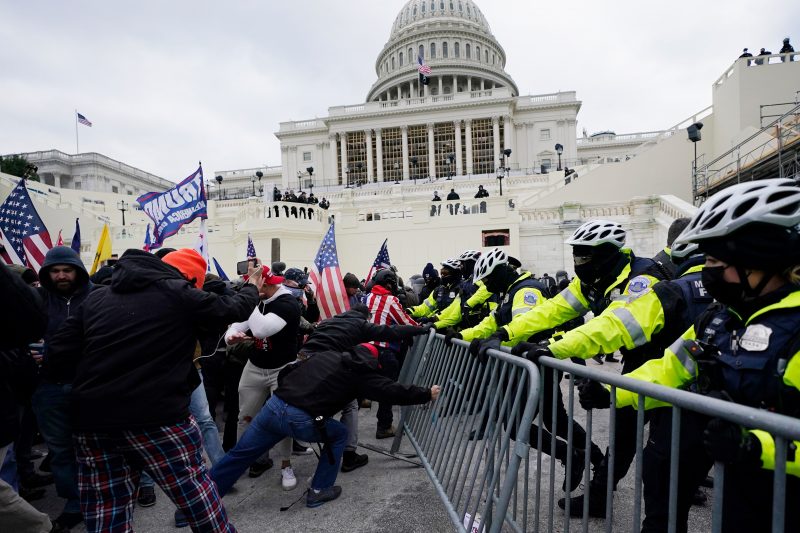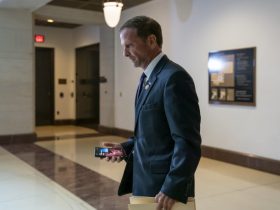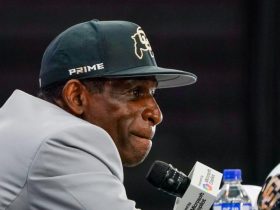Kenneth Thomas was convicted last month for his participation in the pro-Trump riot at the Capitol on Jan. 6, 2021. As he awaits his sentencing later this year, he sought permission to travel to Missouri to participate in a festival dedicated to defendants in Capitol riot cases, permission that the judge overseeing his case denied.
On Thursday night, Thomas’s attorney John Pierce joined CNN’s Abby Phillip to discuss the judge’s decision, with which he predictably disagreed. But over the course of the conversation, Pierce made a broader point about the events of that day: that Jan. 6 was not the violent event that so many have argued.
“January 6th was a very complex event,” Pierce told Phillip. “There were a lot of people who engaged in various kinds of conduct. Mr. Kenneth Joseph Thomas was found not guilty of engaging in violence on the Capitol grounds.”
This is true: The verdict form shows that Thomas was instead convicted on four counts of “assaulting, resisting or impeding certain officers” and “disorderly or disruptive conduct in a restricted building or grounds” but not “engaging in physical violence in a restricted building or grounds.”
What Thomas engaged in, Pierce argued, didn’t constitute violence but a defense of his fellow protesters.
“He was there to protect other people,” Pierce claimed. “There is very clear evidence that there was excessive force by police officers and he was trying to assist an elderly person who was being beaten by batons when he was on the ground.”
Here, he’s referring to one of the moments described in the Justice Department’s criminal complaint against Thomas.
Body-camera footage, it asserts, “showed that, even after law enforcement officers pushed him back, THOMAS returned at least twice to punch or strike the officers with his fist and forearm. THOMAS continued to attack law enforcement this way or attempt to push them back for at least 25 seconds straight.”
In court — and, later, to the right-wing website Gateway Pundit — Thomas argued that this incident involved his trying to get police to give space to a fellow protester who’d fallen on the ground. In a video shared at Gateway Pundit, you can hear Thomas exhorting officers to “let him up.” He is seen in a camel-colored coat and light-tan baseball cap, pushing police back.
But this is only one moment cited in the complaint. There are two others in which Thomas allegedly resisted police efforts to clear the area.
“As the law enforcement officers advanced, THOMAS turned to his side, using his elbow and shoulder to strike the front line officers,” the complaint reads. Video “showed THOMAS push back against the officers in this way four more times and attempt to punch with his fist once, while ordering the rioters to ‘hold the line.’”
Footage Thomas shared on YouTube appears to show these moments. (Removed from YouTube, the video was preserved by jan6archive.com.)
“There was — look, the narrative that, with all due respect to your network, sometimes has been pushed that this was a — just a violent event, that there was violence on both sides,” Pierce told Phillip.
“No, no,” Phillip replied. “It was a violent event. Police officers were there doing their job.”
“Abby,” Pierce said, “some of the police officers were not doing their jobs. Some of the police officers were going way beyond doing their jobs including unjustified lethal force, okay?”
A bit later, he added that “the vast majority — I know this stuff better than you, with all due respect, way better. The vast majority of individuals who are on the Capitol grounds were there and they were peaceful.”
Phillip asked if that included his client. Pierce replied that “we argued at trial that it did and he was found not guilty.”
The divide in perceptions about the riot articulated by Pierce has existed since the attack itself. Do you consider the central aspect of the day to be that thousands of people were present near the Capitol without going inside, much less attacking police officers to do so? Or do you focus instead on those violent actors and their having facilitated the disruption of the counting of electoral votes? Most Americans focus on the latter, the dangerous, deadly exceptions.
But on CNN, as at trial and at the Gateway Pundit, the defense of Thomas draws a more nuanced line. Was Thomas demanding that protesters “hold the line” (as he himself apparently dug in) an unacceptable act of resistance to the police? Was his physically pushing police back, as in the animation above, just a manifestation of a political disagreement?
This question really gets to the heart of what occurred that day. Many of the protesters made clear in their chants and taunts that they believed the police should not stand in their way given that they, the protesters, were defending the Constitution from what they incorrectly believed was an illegitimate election.
They thought the police should side with them — probably because they saw the police as siding with them in general. This was the “back the blue”/“blue lives matter” team! The ones President Donald Trump would recognize to applause at his campaign rallies! But here they’re siding with the left?
There’s a privilege in this. There’s a privilege in assuming that the police should stand aside as you try to overrun the Capitol, certainly, but there’s also a privilege in shrugging at having pushed police out of the way. In the midst of confused, angry protests, there’s often some jostling. And what Thomas is shown doing, at least in the available video, falls short of assaulting police in an effort to inflict injury. But is it therefore excusable? To Pierce’s point, is it even broadly representative? If your view is that the police are generally in alignment with you and should spend their time enforcing laws other people break, then: yes.
Republican politicians have spent the past two-plus years arguing that the government cracked down on Jan. 6 rioters as a proxy for the political right more broadly and/or that those imprisoned were “political prisoners.”
Some of this is opportunistic. Some of it, though, is rooted in the idea that what occurred wasn’t really that bad. That the police generally were acting in a way that they shouldn’t have been acting. It’s the same impulse that pivots from the search for classified documents at Mar-a-Lago to calls to defund the FBI — why are you doing this instead of investigating real crimes?
At another point in the video that Thomas uploaded to YouTube, someone near him in the crowd can be heard shouting.
“This is a peaceful protest!” the voice says. “Antifa’s causing the problem!”
Even at that moment, it wasn’t their fault.








